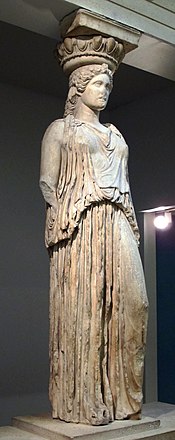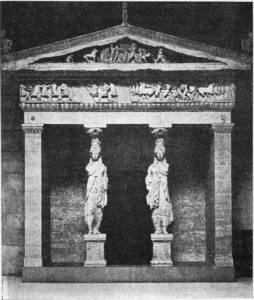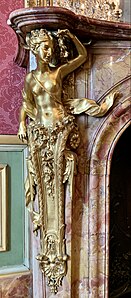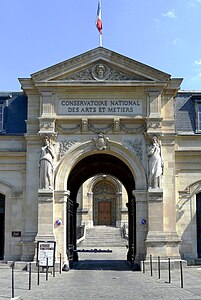Caryatid


A caryatid (
An atlas or atlantid or telamon is a male version of a caryatid, i.e., a sculpted male statue serving as an architectural support.
Etymology
The term is first recorded in the
The ancient Caryae supposedly was one of the six adjacent villages that united to form the original township of Sparta, and the hometown of
A caryatid supporting a basket on her head is called a
The later male counterpart of the caryatid is referred to as a
.Ancient usage

Some of the earliest known examples were found in the treasuries of Delphi, including that of Siphnos, dating to the 6th century BC. However, their use as supports in the form of women can be traced back even earlier, to ritual basins, ivory mirror handles from Phoenicia, and draped figures from archaic Greece.
The best-known and most-copied examples are those of the six figures of the Caryatid porch of the
Although of the same height and build, and similarly attired and coiffed, the six Caryatids are not the same: their faces, stance, draping, and hair are carved separately; the three on the left stand on their right foot, while the three on the right stand on their left foot. Their bulky, intricately arranged hairstyles serve the crucial purpose of providing static support to their necks, which would otherwise be the thinnest and structurally weakest part.
The
Renaissance and after
In
In the 16th century, from the examples engraved for
Many caryatids lined up on the facade of the 1893 Palace of the Arts housing the Museum of Science and Industry in Chicago. In the arts of design, the draped figure supporting an acanthus-grown basket capital taking the form of a candlestick or a table-support is a familiar cliché of neoclassical decorative arts. The John and Mable Ringling Museum of Art in Sarasota has caryatids as a motif on its eastern facade.
In 1905 American sculptor
In Act 2 of his 1953 play 'Waiting for Godot', author Samuel Beckett has Estragon say "We are not caryatids!" when he and Vladimir tire of "cart(ing) around" the recently blinded Pozzo.
Agnes Varda made two short films documenting Caryatid columns around Paris. 1984 Les Dites Cariatides 2005 Les Dites Cariatides Bis.
The musical group Son Volt evoke the caryatides and their burden borne in poetic metaphor on the song "Caryatid Easy" from their 1997 album Straightaways, with singer Jay Farrar reproving an unidentified lover with the line "you play the caryatid easy."
Gallery
-
Ancient Greek caryatids of the Cnidian Treasury, c.550 BC, probably marble, Delphi Archaeological Museum, Delphi, Greece
-
Ancient Greek mirror, 5th century BC, bronze, Archaeological Museum of Ancient Corinth, Corinth, Greece
-
Ancient Greek caryatids of the Erechtheion, Greece, unknown architect, 421-405 BC[17]
-
Eleusis, second half of 1st century BC, probably marble, Archaeological Museum of Eleusis, Elefsina, Greece
-
Las Incantadas, a group of Roman sculptures from a portico that once adorned the Roman Forum of Thessalonica, 150-230 AD, marble, Louvre[18]
-
-
Baroque caryatids on the upper part of the Pavillon de l'Horloge on the Cour Carrée of the Louvre Palace, by Gilles Guérin and Philippe De Buyster after Jacques Sarazin, mid 17th century[20]
-
Baroque caryatids of a cabinet, c.1675, ebony, kingwood, marquetry of hard stones, gilt bronze, pewter, glass, tinted mirror and horn, Museum of Decorative Art, Strasbourg, France[21]
-
Baroque caryatids in the Apollo and Attendants Flaying Marsyas tapestry, 17th century, wool and silk, Minneapolis Institute of Art, Minneapolis, US
-
Versailles, France[22]
-
Pair of Louis XVI style caryatid, 18th century, gilt bronze, Metropolitan Museum of Art, New York City
-
Louis XVI style caryatids on the Médicis Vase, by Louis-Simon Boizot, Pierre Philippe-Thomire and the Sèvres Porcelain Manufactory, c.1787, porcelain and gilded bronze, Louvre[23]
-
Neoclassical caryatids of the portal of the Palais Pallavicini in Josefsplatz, Vienna, Austria, by Johann Ferdinand Hetzendorf von Hohenberg, 1784
-
Empire style table with caryatids en gaine supported by bare feet, early 19th century, wood, metal, glass, pigment, and porcelain, Musée Dufresne-Nincheri, Montreal, Canada
-
Neoclassical porch with caryatids of theErechtheum, by William and Henry William Inwood, 1819-1822
-
Walhalla Temple, near Regensburg, Germany, designed by Leo von Klenze in 1821, built in 1830-1842[24]
-
Neoclassical caryatids of the Winkel van Sinkel department store, Utrecht, the Netherlands, 1837-1839, by P. Adams[25]
-
Neoclassical caryatids of the south wall of the Room of the Niobids, Neues Museum, Berlin, by Friedrich August Stüler, 1845-1850[27]
-
Neoclassical caryatids of Quai de la Mégisserie no. 14, Paris, sculptor Auguste Millet and architect Henri Blondel, 1864[28]
-
Renaissance Revival caryatids on the Jenners, department store, Edinburgh, UK, by William Hamilton Beattie, 1894
-
Musée du Quai Branly, Paris
-
Luba stool with two caryatids, 19th century, wood, Ethnological Museum of Berlin
-
Rococo Revival gilt bronze caryatid on the fireplace in the room 538 of the Louvre Palace, Paris, 19th century, unknown architect or sculptor
-
Pair of Neoclassical caryatids at the entrance of the Conservatoire national des arts et métiers (Rue Saint-Martin no. 292), Paris, unknown architect, mid-19th century
-
Neoclassical caryatids of Rue des Halles no. 19, Paris, designed by Jean Lobrot and sculpted by Charles Gauthier, 1868
-
DoubleBeaux Arts caryatid on the façade of the Théâtre de la Renaissance, Paris, by Charles de Lalande, 1873
-
Beaux Arts caryatid (mainly Neoclassical, but also Baroque Revival through the lower part rotated at 45°) of Rue Chomel no. 11, Paris, by J. Vramant, 1878-1880
-
Neoclassical caryatids of a Wallace fountain in Place Moussa-et-Odette-Abadi, Paris, designed by Richard Wallace and produced by Charles-Auguste Lebourg, late 19th century
-
Art Nouveau caryatid-corbel on the Maison Vallin (Boulevard Lobau no. 6), Nancy, France, 1894, by Eugène Vallin[29]
-
Beaux Arts caryatids of a oriel window of Strada Buzești no. 4, Bucharest, Romania, unknown architect or sculptor, c.1900
-
Beaux Arts atlas and caryatid of Avenue de Tourvill no. 4, Paris, unknown architect or sculptor, c.1900
-
Beaux Arts mermaid caryatids with a cartouche in Le Train Bleu, Gare de Lyon, Paris, 1901, by Marius Toudoire
-
Rococo Revival caryatids of Rue Notre-Dame-des-Champs no. 82, Paris, designed by Constant Lemaire and sculpted by Louis Hollweck, 1904-1905
-
Art Deco caryatids on Banca Albina (Strada Edgar Quinet no. 6), Bucharest, unknown architect or sculptor, c.1930
-
Art Deco caryatids of the Monument to the Unknown Hero, atop Mount Avala, south-east of Belgrade, Serbia, wirhcaryatids representing all the peoples of the Kingdom of Yugoslavia, by Ivan Meštrović, 1934–1938[30]
-
Neoclassical caryatids of the Alley of Caryatids in theHerăstrău Park, Bucharest, dressed like Romanian peasant women, sculpted by Constantin Ricci, 1939[31]
-
Postmodern Venus de Milo caryatids of Rue Frank Lloyd Wright no. 14, Guyancourt, France, by Manuel Núñez Yanowsky, 1992
-
Postmodern caryatids of the Supreme Court of Poland, Warsaw, by Marek Budzynski and Zbigniew Badowski, 1996-1999
-
Postmodern cast stone caryatids inNogales, Mexico, unknown architect, unknown date
-
Caryatides, ca. 1865; from the Nicholas Catsimpoolas Collection of the Boston Public Library
See also
- Caryatid stools in African art
- Term (architecture)
- The Sphere: Große Kugelkaryatide (Great Spherical Caryatid) – WTC sculpture by Fritz Koenig
References
- ^ "Definition of CARYATID".
- ^ Καρυᾶτις in Bailly, Anatole (1935) Le Grand Bailly: Dictionnaire grec-français, Paris: Hachette
- ^ (Kerenyi 1980 p 149)
- ^ Hersey, George, The Lost Meaning of Classical Architecture, MIT Press, Cambridge, MA, 1998 p. 69
- ^ Glittering Images, p. 25
- ^ Black Athena Revisited, p. 197
- ^ caryatide in "Notre grec de tous les jours" by Bernard Sergent
- The Slave in European Art: From Renaissance Trophies to Abolitionist Emblem, ed Elizabeth Mcgrath and Jean Michel Massing, London (The Warburg Institute) 2012
- ^ Alderman, Liz (7 July 2014). "Acropolis Maidens Glow Anew". The New York Times. Retrieved 9 July 2014.
- ^ A. H. Smith, "Gavin Hamilton's Letters to Charles Townley" The Journal of Hellenic Studies 21 (1901: 306–321) p. 306 note 3. Townley inventories, where it is interpolated between No. 9 (Hecate) and No. 10 (Fortune).
- ^ Noted by James Parker, in describing the precedents for the white marble caryatid chimneypiece from Chesterfield House, Westminster, now at the Metropolitan Museum of Art (Parker, "'Designed in the Most Elegant Manner, and Wrought in the Best Marbles': The Caryatid Chimney Piece from Chesterfield House", The Metropolitan Museum of Art Bulletin, New Series, 21.6 [February 1963] pp. 202–213).
- ^ Also noted by Parker 1963:206.
- ^ Both remarked upon by Parker 1963:206, and fig. 9.
- ^ "archsculptbooks.com". Archived from the original on 7 July 2011. Retrieved 29 December 2016.
- ^ "Fallen Caryatid Carrying Her Stone". The Collection Online. Metropolitan Museum of Art. Retrieved January 29, 2015.
- ISBN 978-0-441-79034-0.
- ISBN 978-1-52942-030-2.
- ^ "L'Incantada". collections.louvre.fr. April 0150. Retrieved 5 January 2024.
- ISBN 978-2-7572-0177-0.
- ISBN 978-2-7572-0177-0.
- ^ "Cabinet parisien 17e siècle". musees-strasbourg.skin-web.org. Retrieved 13 September 2023.
- ^ "Serre-bijoux de Marie-Antoinette". 1774. Retrieved 21 September 2023.
- ^ "Vase Médicis". collections.louvre.fr. 1774. Retrieved 13 September 2023.
- ISBN 978-1-52942-030-2.
- ^ "Winkel van Sinkel". openmonumentendag.nl. Retrieved 13 September 2023.
- ^ "Maison en terre cuite de Virebent". pop.culture.gouv.fr. Retrieved 13 September 2023.
- ISBN 978-3-7913-4262-7.
- ^ "Immeuble". pop.culture.gouv.fr. Retrieved 19 January 2023.
- ^ "Immeuble". pop.culture.gouv.fr. Retrieved 13 September 2023.
- ^ "СПОМЕНИК НЕЗНАНОМ ЈУНАКУ НА АВАЛИ (Monument to the Unknown Hero on Avala)". Monuments of Culture of Serbia (in Serbian). National Center for Digitization. Retrieved 16 September 2013.
- ISBN 978-973-0-23884-6.
External links
- Kerényi, Karl (1951) 1980. The Gods of the Greeks (Thames & Hudson)
- Conserving the Caryatids in the Acropolis Museum
- Images of Caryatids of Athens (Spanish)
- Cariatides room of the Louvre on YouTube



![Ancient Greek caryatids of the Erechtheion, Greece, unknown architect, 421-405 BC[17]](http://upload.wikimedia.org/wikipedia/commons/thumb/7/73/Athen_Erechtheion_BW_2017-10-09_13-58-34.jpg/442px-Athen_Erechtheion_BW_2017-10-09_13-58-34.jpg)

![Las Incantadas, a group of Roman sculptures from a portico that once adorned the Roman Forum of Thessalonica, 150-230 AD, marble, Louvre[18]](http://upload.wikimedia.org/wikipedia/commons/thumb/4/4e/Las_Incantadas_%28Louvre%29_3.jpg/225px-Las_Incantadas_%28Louvre%29_3.jpg)

![Renaissance caryatids of the musicians' loft in the Louvre Palace, Paris, by Jean Goujon, 1550[19]](http://upload.wikimedia.org/wikipedia/commons/thumb/b/bf/Paris_Palais_du_Louvre_Salle_des_Caryatides_tribune_20161031.jpg/225px-Paris_Palais_du_Louvre_Salle_des_Caryatides_tribune_20161031.jpg)
![Baroque caryatids on the upper part of the Pavillon de l'Horloge on the Cour Carrée of the Louvre Palace, by Gilles Guérin and Philippe De Buyster after Jacques Sarazin, mid 17th century[20]](http://upload.wikimedia.org/wikipedia/commons/thumb/5/58/Facade_Pavillon_Horloge_Louvre.jpg/198px-Facade_Pavillon_Horloge_Louvre.jpg)
![Baroque caryatids of a cabinet, c.1675, ebony, kingwood, marquetry of hard stones, gilt bronze, pewter, glass, tinted mirror and horn, Museum of Decorative Art, Strasbourg, France[21]](http://upload.wikimedia.org/wikipedia/commons/thumb/3/3b/Antichambre_du_prince-%C3%A9v%C3%AAque_%28Palais_Rohan%2C_Strasbourg%29_cabinet.JPG/200px-Antichambre_du_prince-%C3%A9v%C3%AAque_%28Palais_Rohan%2C_Strasbourg%29_cabinet.JPG)

![Louis XVI style jewelry locket of Marie-Antoinette, by Ferdinand Schwerdfeger, 1787, mahogany, mother-of-pearl inlays, paintings under glass, porcelain plate, and gilded bronzes, Chambre de la Reine, Palace of Versailles, Versailles, France[22]](http://upload.wikimedia.org/wikipedia/commons/thumb/0/01/P1030075_%285015797888%29.jpg/400px-P1030075_%285015797888%29.jpg)

![Louis XVI style caryatids on the Médicis Vase, by Louis-Simon Boizot, Pierre Philippe-Thomire and the Sèvres Porcelain Manufactory, c.1787, porcelain and gilded bronze, Louvre[23]](http://upload.wikimedia.org/wikipedia/commons/thumb/6/60/Vase_Medicis_%28Louvre%2C_OA_9590%29.jpg/225px-Vase_Medicis_%28Louvre%2C_OA_9590%29.jpg)



![Polychrome Greek Revival caryatids of the Walhalla Temple, near Regensburg, Germany, designed by Leo von Klenze in 1821, built in 1830-1842[24]](http://upload.wikimedia.org/wikipedia/commons/thumb/8/8d/Walhalla_Halle1.jpg/423px-Walhalla_Halle1.jpg)
![Neoclassical caryatids of the Winkel van Sinkel department store, Utrecht, the Netherlands, 1837-1839, by P. Adams[25]](http://upload.wikimedia.org/wikipedia/commons/thumb/9/9c/Kariatiden_Winkel_van_Sinkel.JPG/225px-Kariatiden_Winkel_van_Sinkel.JPG)
![Neoclassical white terracotta caryatids of the Virebent Factory, Toulouse, France, by Auguste Virebent, 1840[26]](http://upload.wikimedia.org/wikipedia/commons/thumb/3/3a/Immeuble-cariatides_%282%29.jpg/459px-Immeuble-cariatides_%282%29.jpg)
![Neoclassical caryatids of the south wall of the Room of the Niobids, Neues Museum, Berlin, by Friedrich August Stüler, 1845-1850[27]](http://upload.wikimedia.org/wikipedia/commons/thumb/4/46/South_wall_of_the_Room_of_the_Niobids%2C_Neues_Museum%2C_Berlin.jpg/184px-South_wall_of_the_Room_of_the_Niobids%2C_Neues_Museum%2C_Berlin.jpg)
![Neoclassical caryatids of Quai de la Mégisserie no. 14, Paris, sculptor Auguste Millet and architect Henri Blondel, 1864[28]](http://upload.wikimedia.org/wikipedia/commons/thumb/d/d9/Paris_Quai_de_la_M%C3%A9gisserie_543.jpg/200px-Paris_Quai_de_la_M%C3%A9gisserie_543.jpg)









![Art Nouveau caryatid-corbel on the Maison Vallin (Boulevard Lobau no. 6), Nancy, France, 1894, by Eugène Vallin[29]](http://upload.wikimedia.org/wikipedia/commons/thumb/8/80/D%C3%A9tail_de_la_fa%C3%A7ade_06939_%28cropped_caryatid%29.jpg/239px-D%C3%A9tail_de_la_fa%C3%A7ade_06939_%28cropped_caryatid%29.jpg)






![Art Deco caryatids of the Monument to the Unknown Hero, atop Mount Avala, south-east of Belgrade, Serbia, wirhcaryatids representing all the peoples of the Kingdom of Yugoslavia, by Ivan Meštrović, 1934–1938[30]](http://upload.wikimedia.org/wikipedia/commons/thumb/d/da/Spomenik_Neznanom_junaku_1.JPG/400px-Spomenik_Neznanom_junaku_1.JPG)
![Neoclassical caryatids of the Alley of Caryatids in the Herăstrău Park, Bucharest, dressed like Romanian peasant women, sculpted by Constantin Ricci, 1939[31]](http://upload.wikimedia.org/wikipedia/commons/thumb/d/d1/Aleea_Cariatidelor_de_Constantin_Baraschi.jpg/520px-Aleea_Cariatidelor_de_Constantin_Baraschi.jpg)



